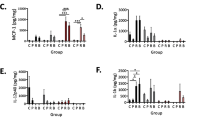Abstract
We investigated the effect of enteral glutamine on intestinal permeability and bacterial translocation after whole abdominal radiation in rats. Rats irradiated with 10 Gy to the abdomen were randomly divided into a glutamine-free diet group and a glutamine-rich diet (2% glutamine) group. After 3 days of feeding of each diet, the 6-h urinary recovery of polyethylene glycol 4000 was significantly decreased in the glutamine-rich diet group compared to that in the glutamine-free diet group. The 6-h urinary recovery of phenolsulfonphthalein was also decreased in the glutamine-rich diet group, but the difference was not significant. Plasma endotoxin concentration was significantly lower in the glutamine-rich diet group. Twenty-four hour after gavage with14C-labeledEscherichia coli, the detection rate of14C-labeled bacteria in the mesenteric lymph nodes of rats was significantly lower in the glutamine-rich diet group. The adherence of14C-labeledE. coli in the jejunal mucosa was significantly lower in the glutamine-rich diet group than in the glutamine-free diet group, but there were no significant differences in the ileal mucosa. These findings suggest that in rats with intestinal injury induced by irradiation, enteral glutamine maintains the intestinal barrier and reduces bacterial translocation.
Similar content being viewed by others
References
Souba WW, Herskowitz K, Salloum RM. Gut glutamine metabolism. J Parenertal Enteral Nutr 1990;14:45S-50S.
Alexander JW, Gianotti L, Pyles T, et al. Distribution and survival ofEscherichia coli transolcating from the intestine after thermal injury. Ann Surg 1991;213:558–567.
Redan JA, Rush BF, McCullough JN. Organ distribution of radiolabeled entericEscherichia coli during and after hemorrhagic shock. Ann Surg 1990;211:663–667.
Souba WW, Klimberg VS, Hautamaki RD. Oral glutamine reduces bacterial translocation following abdominal radiation. J Surg Res 1990;48:1–5.
Souba WW, Klimberg VS, Copeland EM. Glutamine nutrition in the management of radiation enteritis. J Parenteral Enteral Nutr 1990;14:106S-108S.
Nambu T, Tadao B, Hosoda S. Promotion of healing by orally administered glutamine in elemental diet after small intestinal injury by X-ray radiation. Asia Pac J Clin Nutr 1992;1:175–182.
Rush BF Jr, Raden JA, Flanagan JJ Jr, et al. Does the bacteremia observed in hemorrhagic shock have clinical significance? A study in germ-free animals. Ann Surg 1989;210:342–347.
Ravin HA, Rowley D, Jenkins C, et al. On the absorption of bacterial endotoxin from the gastro-intestinal tract of the normal and shocked animal. J Exp Med 1960;112:783–792.
Cuevas P, Fine J. Demonstration of lethal endotoxemia in experimental occlusion of the superior mesenteric artery. Surg Gynecol Obstet 1971;133:81–83.
Gans H, Matsumoto K. The escape of endotoxin from the intestine. Surg Gynecol Obstet 1974;139:395–402.
Nolan JP, Hare DK, McDevitt JJ, et al. In vitro studies of intestinal endotoxin absorption. I. Kinetics of absorption in the isolated everted gut sac. Gastroenterology 1977;72:434–439.
Hollander D, Ricketts D. Importance of “probe” molecular geometry in determining intestinal permeability. Can J Gastroenterol (Suppl) 1988;2:35A-38A
Carter EA, Tompkins RG, Schiffrin E, et al. Cutaneous thermal injury alters macromolecular permeability of rat small intestine. Surgery 1990;107:335–341.
Shiau S, Chang GW. Effects of certain dietary fibers on apparent permeability of the rat intestine. J Nutr 1986;116:223–232.
Elsenhans B, Caspary WF. Differential changes in the urinary excretion of two orally administered polyethylene glycol markers (PEG900 and PEG 4000) in rats after feeding various carbohydrate gelling agents. J Nutr 1989;119:380–387.
Sandqvist T, Magnusson KE, Tagesson C, et al. Passage of molecules through the wall of the gastrointestinal tract. Gut 1980;21:208–214.
Lowry OH, Rosebrough NJ, Farr AL. Protein measurements with Folin phenol reagent. J Biol Chem 1951;193:265–275.
Nakamura J, Takeda S, Ohtsuka N, et al. An assessment of indomethacin-induced gastrointestinal mucosal damage in-vivo: Enhancement of urinary recovery after oral administration of phenolsulfonphthalein in rats. J Pharm Pharmacol 1983;35:369–372.
Obayashi T, Tamura H, Tanaka S, et al. A new chromogenic endotoxic-specific assay using recombined limulus coagulation enzymes and its clinical applications. Clin Clim Acta 1985;149:55–65.
Gelland RB, Spencer J. Surgical management of radiation enteritis. Surgery 1986;99:133–139.
Okabe S, Honda K, Takeuchi K, et al. Inhibitory effect ofl-glutamine on gastric irritation and back diffusion of gastric acid in response to aspirin in the rat. Dig Dis 1975;20:626–635.
Fox AD, Kripke SA, Berman JR, et al. Reduction of the severity of enterocolitis by glutamine-supplemented-enteral diets. Surg Forum 1987;38:43–44.
Barber AE, Jones WG II, Minei JP et al. Bacterial overgrowth and intestinal atrophy in the etiology of gut barrier failure in the rat. Am J Surg 1991;161:300–304.
Berg RD, Wommack E, Deich EA. Immunosuppression and intestinal bacterial overgrowth synergistically promote bacterial translocation from the GI tract. Arch Surg 1988;123:1359–1364.
Flynn WJ, Gosche JR, Garrison RN. Intestinal blood flow is restored with glutamine or glucose suffusion after hemorrhage. J Surg Res 1992;52:499–504.
Bjarnason I, Macpherson A, Hollander D. Intestinal permeability: An overview. Gastroenterology 1995;108:1566–1581.
Travis S, Menzies I. Intestinal permeability: Functional assessment and significance. Clin Science 1992;82:471–488.
Dugan MER, McBurney MI. Luminal glutamine perfusion alters endotoxin-related changes in ileal permeability of the piglet. J Parenteral Enteral Nutr 1995;19:83–87.
Skarnes RC. In vivo distribution and detoxification of endotoxins. In: Berry LJ (ed) Handbook of endotoxin. vol. 3. Amsterdam: Elsevier Science, 1985;56–81.
Freudenberg MA, Freudenberg N, Galanos C. Time course of cellular distribution of endotoxin in liver, lungs and kidney of rats. Br J Exp Pathol 1982;63:56–65.
Guo W, Anderson R, Ljungh A, et al. Orally administered phospholipids inhibit abdominal rubber-drain-induced bacterial translocation in the rat. Digestion 1994;55:417–424.
Alverdy JC. Effects of glutamine-supplemented diets on immunology of the gut. J Parenteral Enteral Nutr 1990;14:109S-111S.
Ardawi MSM, Newsholme EA. Maximum activities of some enzymes of glycolysis, the tricarboxylic acid cycle and ketone-body and glutamine utilization pathways in lymphocytes of the rat. Biochem J 1982;208:743–748.
Taudow G, Wiart J, Panijel J. Influence of amino acid deficiency and tRNA aminoacylation on DNA synthesis and DNA polymerase activity during the secondary immune response in vitro. Mol Immunol 1983;20:255–261.
Author information
Authors and Affiliations
Rights and permissions
About this article
Cite this article
Chun, H., Sasaki, M., Fujiyama, Y. et al. Effect of enteral glutamine on intestinal permeability and bacterial translocation after abdominal radiation injury in rats. J Gastroenterol 32, 189–195 (1997). https://doi.org/10.1007/BF02936366
Received:
Accepted:
Issue Date:
DOI: https://doi.org/10.1007/BF02936366




